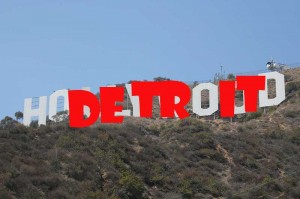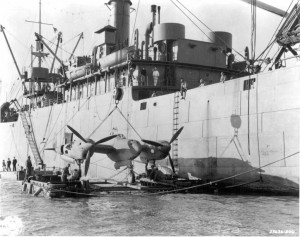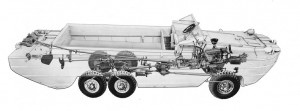
Could the Motor City become Tinseltown East?
Amidst all the gloom-and-doom news emanating from and about Detroit lately, it was announced that a new Michigan-based movie production company would take over General Motors’ former Centerpoint office complex in Pontiac, a fairly distant northern suburb of the Motor City.
Centerpoint? The old timers know it as “T & C,” a yellow brick office building and factory on South Boulevard just east of Woodward at the southern end of the city. Pontiac Motor Car Division used to anchor the city’s northern edge. T & C stood for Truck and Coach, once known as Yellow Coach, the General Motors division that manufactured GMC buses (“coaches”) and GMC heavy trucks, having introduced modern diesel engines for trucks in 1938.
Michigan, copying some other states, is providing special financial and tax incentives for companies willing to establish movie production facilities in the Wolverine state. Detroit environs have been featured in several films lately, notably Clint Eastwood’s Grand Torino, although the original script was set in Minneapolis.
What few people remember today is that Detroit once was second only to Hollywood in film production. But Detroit movies weren’t feature films for entertainment. Instead they were promotional films for auto companies and training films for auto company and dealer personnel.

Thousands of Hollywood's finest contributed to the war effort.
Thousands of Detroiters—actors, actresses, writers, directors, cameramen, lighting technicians, prop-makers, film processors, and makeup and costuming experts–were employed in this supplier industry to the auto industry. The leader was a company named Jam Handy, with offices and studios a few blocks east of the General Motors Building along Detroit’s Grand Boulevard.
When movie theaters were a primary source of both information and entertainment for the public, automakers induced theaters to screen promotional movies about their cars, inserted among newsreels, cartoons, previews and the customary double feature picture shows of the 1920s to 1950s.
A high point for Michigan’s movie industry was reached during World War II, when Handy and other Detroit studios produced training films for the military and related war efforts. But Detroit’s movie production business evaporated during the 1960s.
Indeed, a newborn Michigan feature (entertainment) film studio could do a lot worse than relating the story of its new home, if that home happens to be the former T & C headquarters and factory. (Another studio supposedly will locate in a former IRS office building, later a gambling casino, in downtown Detroit.)

GM's amphibious DUKW, or "Duck."
For T & C was the home of two of World War II’s most famous and victory-assuring vehicles: the GMC 6×6 two-and-a-half-ton truck, variously known as “Six-By” or “Deuce-and-a- Half” by soldiers, and the amazing DUKW, an amphibious version of the workhorse 6×6. The DUKW was called “Duck” for obvious reasons, but its letter combination actually was the General Motors product code for the type and year of the design.
According to my–pardon me for self-promotion—2007 Arcadia book, “Detroit’s Wartime Industry: Arsenal of Democracy.” General Motors built 562,750 Six-Bys before ending production in September 1945. Among other feats, the Six-By made the Red Ball Express possible, the highway provisioning of Allied armies moving across France to Germany following the breakout from the Normandy invasion in 1944.
GMC built more than 21,000 DUKWs from 1942 to 1945. The Duck became invaluable in Pacific island invasions as well as crossing numerous rivers and streams in Europe where most bridges had been destroyed. Ingenious Army and Navy cargo experts in the Pacific found that by lashing two Ducks together, they could transport such equipment as a P-38 fighter, a half-track armored vehicle or a 35-ton Sherman M-4 tank from ship to shore.
How the Ducks came about would make a good bioptic in the hands of the right scriptwriter. A floating truck? What a ridiculous idea—they’ll sink. But a handful of T & C engineers and some visionary Army Ordnance Department officers had faith, and an unplanned rescue attempt by a Duck in Massachusett’s Cape Cod Bay proved the land-sea vehicles’ seaworthiness–and the rest is history. A few Ducks still remain today in civilian service, ferrying tourists around resorts like Honolulu.
Development of the trusty GMC Six-By was hardly the stuff of Hollywood story-telling. GM began building prototypes for the Army as early as 1931, and the Army issued its first production contract to GM in 1939. Literally millions of American and Allied forces World War II and Korean War service personnel rode in GMC Six-Bys between 1939 and their phase-out in 1956. No doubt there are some still serving Third World armies even today.
General Motors decided to get out of the coach and heavy truck business in the early 1980s. The GMC brand was attached to badge-engineered Chevrolet light trucks and largely assigned to Pontiac dealers. So T & C disappeared with hardly a whimper but lots of memories.
An authoritative military vehicle historian has noted: “World War II was the first war in which massive numbers of trucks completely changed the equations of mobility for warfare. The productive capability of the U. S. automotive industry poured out hundreds of thousands of jeeps, trucks and armored vehicles. This made it possible for the U. S. and its allies to overwhelm the Axis with men and supplies, moving forward at a rate never before possible.”
No doubt the historian really was thinking of the General Motors Truck and Coach Division’s Six-By. In a sense it was WWII’s unsung vehicle hero, never gaining the panache of the ubiquitous Jeep.
So a movie studio may be moving into a truly historic site in automotive history.
